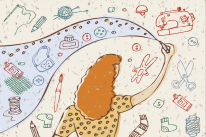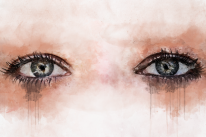
“When we lose someone we love we must learn not to live without them, but to live with the love they left behind.” ~Unknown
If I look like my best friend just died, that’s because he has. Not the one whom I played with every day growing up and haven’t seen in years, nor the one with whom I went to high school and stayed connected with on social media.
No. I lost my very best friend of nearly four decades. My gay “husband,” who lived with me for fourteen years and helped me raise my two youngest sons, from ages three and six until they grew up and left our nest. The same human who I loved endlessly and drove me crazy, not in equal parts because our connection was so strong and the “driving crazy” went along with the complete love package.
I lost the friend who made me laugh like no other human being ever has or will, who has left a hole so big in my heart that I am sure a doctor listening to my chest would know.
As an artist and art therapist, I have found much purpose working in grief and bereavement. The benefits of the visual arts in this work are well documented, with reports of greatly improved well-being, meaning making, and continuing bonds with those who have passed.
And yet, knowing all this, serving many others in this difficult journey, and even losing my own father, my very best friend leaving the earth brought forward a new level of something. Pain? Yes, of course; the raw kind that physically rips through the body and soul, abates, and begins again. Loss? Like nothing I have ever felt or can describe. Grief? I am not sure I even knew what the word meant, until now.
But here’s what I didn’t anticipate: a deeply felt different “frequency” of love that was equally as palpable as my pain.
Ironically, it occurred as I was leading a grief retreat called “The Art of Bereavement,” only two weeks after my best friend transitioned.
It didn’t result from a discussion of dreams, mediums, or strange sightings, although this particular group was eager to share their experiences with all of these things. It happened through the very practice I was offering.
Since the workshop was only ninety minutes, I had decided on mixed media, which is typically engaging to everyone—paints in every color and a plethora of collage materials like magazines, textured papers, sand, glitter, stickers, and shells. These would be used on round canvases as symbolic “mandalas,” which have been found in art therapy to contain difficult emotions and are known for soothing the soul.
After explaining the process and materials, I guided the group inward through a short meditation. I began working on my mandala alongside them, choosing materials my friend would love: zebra paper, a touch of leopard, glitter, black paint, and a few rhinestones; words to our favorite song from Evita.
Suddenly, I noticed something stirring deep inside my being, I felt the love of my departed friend coming forward in a powerful, beautiful way that I had never experienced in life.
Since I was teaching, I was completely caught off guard, but there it was. Rather than dismissing what was happening, I spontaneously shared with my group.
In that moment, as a result, something else as equally profound occurred: the people I was facilitating in their heart-wrenching grief began holding the space for mine.
A few of them paused their work and gathered around me. They asked questions—who he was to me, why I had chosen the materials I chose, what I would miss the most. With tears streaming down my face, I told them… he was a special kind of soulmate with a connection that could not be compared to anyone else. He was a brilliant artist, my dearest friend and my family.
I shared that he will make me laugh forever and how I am not sure what life can possibly be like without him. I let them know how devastated I was for my sons, who had also lost their birth father several years after we divorced. Someone hugged me and another cried. They all listened intently while looking at my mandala, honoring my loss alongside of theirs.
As the teacher became the student, I was humbled. And the profound love I had experienced was now filling the room. No longer were we separated by any notion of “retreat” or “therapist.” We were fully united as humans, in the ubiquitous experience of deep loss and love.
I was moved to ask if anyone else wanted to bring their departed loved one into the room, through the art they were making and the materials they had chosen.
A moment didn’t pass before everyone was taking turns. Someone’s wife had spent all of her free time in nature, so her mandala was covered with trees. A young woman’s sister had adored her cat, so hers was covered with images of kittens. For a departed husband, musical notes and a guitar symbolized his passion for song.
The mandalas were full of rainbows, words, landscapes, and hearts, all lifting up the essence of those who were no longer with us. And yet, through image, symbol, and metaphor, each and every one of them was there.
As I closed the group, I deeply thanked everyone for holding the space for my grief, something I will never forget. I gave thanks to them for attending, as well as to the energies of their lost loved ones for being present. I invited them to continue working on and visiting with their mandalas, whenever they were called. I reminded them to honor the kittens and rainbows, to sing favorite songs and to creatively stay connected, in whatever way made sense for them.
I let them know how grief is completely different for everyone, that there is no right or wrong, and that they should each follow whatever path worked, including seeking outside support.
Inviting everyone to take a few more final deep breaths together, I lifted up the idea of sharing the profound human connection we had all experienced that day, reminding them that we are never really alone in our loss. And, as they had all helped me, they each had the capacity to help someone else.
“In the end,” I said, “we are all both teachers and students. Namaste.”
At Home “Art of Bereavement” Practice
If you’d like to create your own art to honor the loss of someone you loved and help process your feelings, give this practice a try.
Grief work can be extremely difficult, and many communities offer free grief groups and counseling services. If any part of this practice becomes too challenging, please honor your experience and move to something else. There is no right, wrong, good or bad to grief work, including the artmaking.
Materials: heavy paper, preferably watercolor or mixed media
Special photos, meaningful writing or words, images symbolic of your loved one from google or magazines, stickers, paint, glue, any scrapbooking materials, or tissues.
1. Get quiet.
Eyes opened or closed, notice whatever is coming up in your body. Do your best to breathe into it or around it, just for a few minutes.
2. Bring to mind a special memory of your loved one, tuning into the sensory experience.
What colors do you see? What sounds stand out? What do you feel? If any of this becomes too difficult, focus only on your breath.
3. Draw a circle on your paper, either freehand or by tracing a round shape.
4. Allow the materials to “call.”
Without much thought, begin using your materials to collage and paint inside of your circle.
5. Tune in.
Art materials are a wonderful path to mindfulness. Notice how the paint flows, the paper sounds, and the textures feel.
6. Open to the experience.
If tears come, let them flow; if you need a break, step aside.
7. Take your time.
Once you feel “done,” reflect on your work and how you are feeling. Notice if this creative approach has helped you in any way.
8. Honor the image.
Put your art in a special place where you can visit with it when you are moved to do so. If it feels right, share your art with loved ones.
9. Be gentle with yourself.
Give yourself love and compassion for doing this work and be sure to seek outside support if needed.
About Elizabeth Bryan-Jacobs
Elizabeth Bryan-Jacobs is an artist, art therapist, and bestselling Chicken Soup for the Soul and Soul Models author. She is passionate about awakening clients to the healing trifecta of creativity, mindfulness, and nature and the transformative power of dreamwork, facilitating an ongoing journey of connection and enlightenment. Elizabeth shares creativity retreats at exclusive venues like Canyon Ranch and the Golden Door Spa. She works privately and with groups and can be found at www.creativeawakenings.net.













 Though I run this site, it is not mine. It's ours. It's not about me. It's about us. Your stories and your wisdom are just as meaningful as mine.
Though I run this site, it is not mine. It's ours. It's not about me. It's about us. Your stories and your wisdom are just as meaningful as mine. 